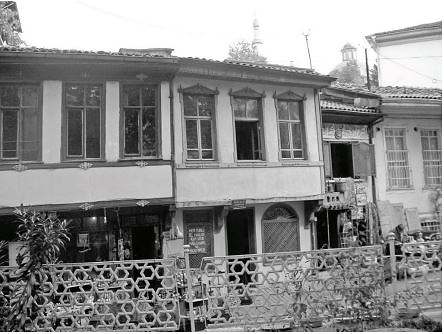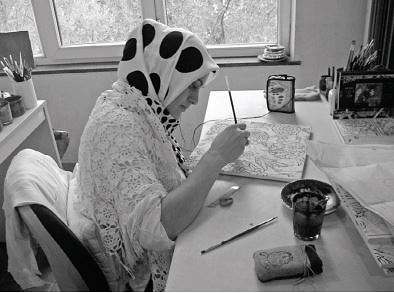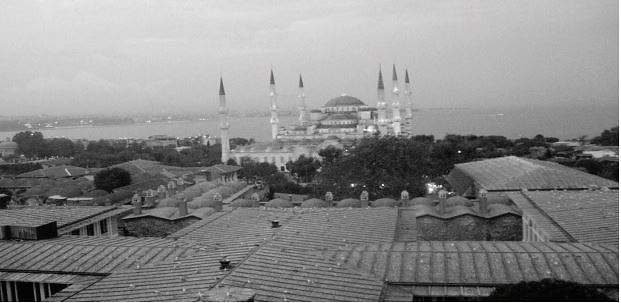MARMARA REGION
The road to Çanakkale was scenic, with interesting stops — a refreshing mixture of fresh pomegranate and orange juice was squeezed as I watched; colorful hand-woven textiles from nearby villages proved irresistible; olives and olive oil in Edremit beat Istanbul prices. Villages gave way to resort towns with apartment blocks by the water; satellite dishes blanketed rooftops; a restaurant billboard read “It is not where you live but where you are fed that counts.”
An inland road took us by fields of roses cultivated for sale; open trucks heaped with melons and crates of tomatoes and potatoes chugged along. As night approached goats descended from the mountains; roadside stands closed down under plastic covers; people in long coats and headscarves rushed home for iftar. Then a big Trojan horse sculpture appeared by the seaside — we were in Çanakkale. Our hotel, the Akol, did a good job of managing the tour groups, who were there to visit nearby Troy.
Çanakkale (the name means “Clay Fortress” in Turkish) is strategically located at the Dardanelles, across from Gelibolu (Gallipoli). The strait is named after the legendary king of Troy, Dardanos; its history is one of people battling each other for control of this narrow passage, which unites the Mediterranean and Aegean with the Marmara and Black Seas. The last battle here was when the British attacked Gallipoli to reach Istanbul during World War I. Under the command of Atatürk the Turks battled for eight months, losing 400,000 soldiers. Giant letters reading “18 Mart 1915” (“18 March 1915,” the date of victory) adorn the hillside in Çanakkale. This international passage, with its rough waters and undercurrents, is now open to all.
Truva (ancient Troy) is 32 kilometers south of Çanakkale. It was lost to legend until Heinrich Schliemann, a German-born businessman and amateur archeologist from California, rediscovered it in 1871. He uncovered superimposed towns going back to 3000 BC. Troy used to be a coastal fishing village until the sea filled in, moving the settlement inland. The revealed cities called “Troy I” to “Troy V” were of similar culture. The site took on a new character with Troy VI (1800-1275 BC). This was the city of Priam, which engaged in the decade-long Trojan War.
According to Homer, Troy was taken by the Greeks when Odysseus came up with the idea of a wooden horse filled with soldiers — the Trojan Horse, which the Trojans pulled inside the city walls, thinking it was a gift from the gods. Another theory is that an earthquake brought down the walls in 1275, hastening the Greek Achaeans’ victory; so in gratitude to Poseidon the Earth Shaker, they built a monumental wooden statue of Poseidon’s horse.
Troy IX is a Roman city (300 BC – 300 AD). Ruins have been found of all nine ancient cities, one on top of the other. As houses with thatched roofs collapsed over time, new ones were built. The different strata are well marked. A replica of the Trojan horse sits on the site, which reserves few thrills. However, the semi-legendary antiquity and the beauty of the setting are worth a visit.
Our trip continued north by the Dardanelles, and then along the southern shores of the Marmara Sea, dotted with vacation towns. The ever-changing scenery included cargo ships on rough waters, fields of purple wild thyme, irrigated rice paddies on flat land, and harvested sunflower stalks bent by the wind. In Biga, school children in uniforms crowded the streets at the end of their morning shift. Road construction brought us to a crawl. Our bus developed a filter problem outside of Bandırma. We decided to stop for lunch at a nearby truck stop while our driver cleaned out the filter. People were friendly; we did not seem to bother the all-male clientele. The place was clean and the food tasty.
Back on the road, we saw that fields had been claimed by small industries — poultry farms; food processing plants; an animal husbandry institute; and furniture, marble, and textile workshops. Near the town of Karacabey, vendors sold small winter melons and honey by the roadside. We also passed by a bird sanctuary. Soon afterwards, the city of Bursa (ancient Prusa) sprawled before us. The entry to what was billed as “green” Bursa teemed with billboards and automobile assembly plants. We reached Çekirge, a suburb known for its thermal baths, which became our home for two nights.
The Byzantine city of Prusa grew to importance with its thermal baths and silk trade during Emperor Justinian’s time. The importation of silkworms and the establishment of looms began an industry that survives to this day. Bursa was the first capital of the Ottoman Empire, and as such renowned for its royal mosques, markets, and covered bazaar. The city, Turkey’s fifth largest, lies on the slopes of Uludağ, a winter ski resort and summer hiking center.
Our exploration began on foot near the hotel to avoid rush hour traffic. We visited the Mosque of Sultan Murat I, which dates from 1366. Built in rows of brick and stone, the mosque has a second-story medrese and a single minaret, and is very plain, devoid of any tile work. It accommodates 2500 people at a time and has a prayer balcony for the Sultan. Across from the mosque is the Sultan’s tomb, along with those of a son and grandson.

Ottoman homes in Bursa
At one of Bursa’s old homes, restored as a restaurant, we stopped for tea, a Turkish tradition. Then we walked the cobbled streets, admiring the architecture of Ottoman homes with bay windows, gazed at the array of sweets in shop windows, watched people line up at bread ovens, and marveled at two policemen managing rush hour congestion at a traffic circle.
In the morning we drove about 1000 meters up Uludağ to a 599-year-old sycamore tree. Sycamores are traditionally planted in village squares; this majestic one, secure in its position by a spectacular view of the mountainside, welcomed passers-by with outstretched arms. Extended on the northern foot of the 2600-meter-high mountain is the city of Bursa. The city is surrounded by chestnut, walnut, peach, and cherry trees, and is famous for its candied chestnuts and aromatic peaches.
Returning to the city, we visited several of the more than 100 mosques that dot its landscape. Muradiye, an early Ottoman mosque complex built from 1366 to 1386, was the first to include buildings for social services. Its beautiful grounds house a bath, a public kitchen, a fountain, and a medrese. Ulu Cami (the Great Mosque), completed in 1399, is impressive in size. Twelve great columns support twenty domes, intended to create a sense of God’s grandeur. It has a central marble pool and ablution fountain. Light comes in from the windows of the domes. The minber (pulpit) is made of carved walnut. We were unable to see the famed Yeşil Cami (Green Mosque) due to restoration work.
A restored Ottoman home is Bursa’s Ethnographic Museum. Different rooms in the museum show the men’s receiving and living areas, as well as the women’s quarters, where mannequins clad in silk sit embroidering or rocking a cradle. Impressive jewelry and costumes complete the collection. Afterwards for lunch we enjoyed iskender kebap — thin slices of meat roasted on a vertical rotating spit and served on pita bread with garlic yogurt. This dish, named after Alexander the Great, is a local specialty.
Following a brief tour of Koza Han (the Cocoon Caravanserai) and the Covered Bazaar, Evin left us to explore on our own. Delighted with this opportunity, I wandered in and out of the little shops that lined the two stories of the han. Much to my surprise, I discovered that many of the silk scarves and shawls displayed were from China or India. I managed to purchase two locally made scarves, one with a sultan’s insignia motif and the other from raw silk, the color of a pomegranate. Reasonable prices followed compliments on my fluency in Turkish.
My time in the Covered Bazaar and the market for local specialties like towels and cutlery was brief. Bayram (the holiday following Ramadan) was approaching, and the situation in the market resembled the mayhem of Christmas shopping in the West. I returned to the hotel in a dolmuş (the name literally means “stuffed”) — a type of taxi which only starts when filled with passengers, each of whom pays separately.
In the morning on our way out of town, we passed the University Hospital; signs displaying the eye surgery and cardiac arrhythmia units underlined Bursa’s importance in health care, beyond its thermal waters. Stands with locally grown onions, tomatoes, and quince, interspersed with boxes of candied chestnuts and “floss halva,” reminded us that there was more to Bursa than suggested by the factory-lined highway. Uludağ, shrouded in fog, formed a magical backdrop to this multifaceted city.
Traveling north to the town of Gemlik on the bay, we drove by olive groves, fields of ornamental flowers, and tree nurseries. Near the Gemlik shipyard we turned east, skirting Lake İznik. The approach to the town of İznik was picturesque. The lakeside was lined with one-story homes amidst fruit trees, tea gardens with checkered tablecloths, and cypresses. The hillside was dotted with homes with small windows; these homes were made of a mixture of old and new mud bricks, and strengthened with wooden armatures. Women on tractors, heads covered, signaled progress.
The ancient city of İznik may have been founded around 1000 BC. Lysimachus, one of Alexander the Great’s generals, reestablished the city in 316 BC, naming it after his wife, Nicaea. This city became the capital of Bithynia, and in 74 BC was given to the Roman Empire. With the rise of Constantinople, Nicaea took on new importance, becoming the venue for the first and last Ecumenical Councils, where representatives of all Christian churches met. In 1080 the city was captured by the Seljuks, followed by the Ottomans in 1331.
Walls that have been stormed by many invaders still enclose most of the present town. The Haghia Sophia Church, built by Justinian, is now a museum with a minaret, having gone through several incarnations. It was converted into a mosque in 1331, and restored by the architect Sinan in the 16th century. The most recent destruction of the building was during the war between Greece and Turkey in 1922. The site is significant as the meeting place of the Seventh (and last) Ecumenical Council in 789.
The İznik Archeological Museum has ancient pots, a good collection of old İznik ceramics, as well as jewelry and early coins made of copper, silver, gold, and nickel. The history of tile making in the city dates back to the 14th century, when ceramic masters were brought from Persia. The craft developed, with 300 workshops during Sultan Süleyman’s time in the 16th century. Beautiful İznik tiles are distinguished by their mastery of design and color, especially a tomato red that has been difficult to replicate.

Artisan in İznik Tile Foundation
Many small tile shops surround İznik’s historic sites. I stopped in one, where a scarf with Turkish hand-embroidered edges caught my eye on the shelf. Anatolian women express emotions through the colors and motifs they depict in this unique craft. The shop owner said the scarf was from his wife’s dowry and that he had fifteen such scarves all together. Having kept them in a chest for 25 years, his wife no longer found them useful and wanted to sell them. Her daughters did not want them; she herself had moved on to modern head covers. Seeing the life story of this woman unravel in these beautiful scarves, I alerted my travel companions to the lucky find. Touched by the woman’s story, one person made a generous donation and bought the scarves as gifts for the rest of the group. Amazed at their fortune, the shopkeeper promised to give the money to his wife.
The İznik Foundation is a nonprofit organization founded to revive the ancient art of making ceramic tiles. The foundation is open to visitors and serves lunch with advance notice. An appetizer of celeriac in olive oil and a milk pudding flavored with mastic were delicious. We toured the workshops, beginning in one where clay is mixed with quartz and glass and poured into molds, followed by firing and sanding. A pin is used to prick along the lines of a drawing, which is then rubbed with powdered charcoal, transferring the design onto a tile. After the contours are drawn, the design is filled in with colors, their order determined by the thickness of the glazes. Copper oxide for turquoise is applied first, iron oxide for red last. Once the glazing is complete, liquid glass is poured over the tile before the final firing. The artisans we saw, all women, were working on a large mural for the naval academy. In the showroom I bought a star-shaped turquoise tile with a Seljuk design around the border.
The trip was coming to an end. Our bus headed to Yalova to catch the car ferry to Istanbul. We had a final glass of tea in an outdoor garden while waiting for the ferry. Shortly after we had boarded, minarets lit up, signaling iftar. Attendants passed out dates to the passengers. (Fasting is often ended with the eating of a date, a holy food in Islam). As we approached Istanbul, lights studded its hills; old mosques glowed like gold crowns in the nightscape — a spectacle matched only by the stars overhead.

Blue Mosque at dusk
Turkey is a country rich in unique beauty, history, and culture. We passed through five geographic regions of the country, each different not only in climate, but also in folklore, cuisine, and local color. As someone who has lived outside the country for a long time, I was able to observe it from the perspectives of both outsider and insider, with sensitivity to its development as well as its problems. While I rejoice at Turkey’s economic growth and general progress, I cannot be oblivious to its social slide to the right. This change is most visible in the way people dress now, compared to the days of my youth. A recent survey indicates that more people in Turkey now identify themselves as Muslim first and Turkish second, which was not the case several years ago.
The stumbling blocks the European Union places on Turkey’s path to membership threaten to lead to a loss not only for Europe, but for the world at large. The concessions the EU expects from Turkey can be made over time. Ultimatums have proved to be ineffective policy, as opposed to diplomacy and patience. I hope those leaders against Turkey’s joining the EU adopt a more accommodating attitude soon.
A historical land bridge between east and west, north and south, Turkey is a treasure trove for archeologists, with 80 digs currently underway, each one revealing a different layer of history. Deeply rooted in the East culturally, but looking to the West as a democratic and secular Islamic country, Turkey is always a fascinating place.
→ Peru
